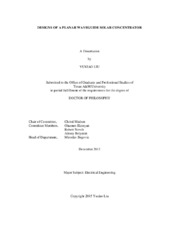| dc.description.abstract | Solar energy, especially through the use of photovoltaic cells, is a promising sustainable energy source for human race. III-V multijunction photovoltaic cells with over 40% confirmed efficiency are among the best candidates for next generation solar cells. However, due to their complex fabrication process, these solar cells are currently too expensive for terrestrial 1 sun use. By using solar concentrators to replace sunlight collection area with cheap materials, total system cost is reduced and cell efficiency is increased. As a result, solar concentrators are viewed as an indispensable part in today’s multijunction photovoltaic cell systems.
A novel planar waveguide solar concentrator is proposed in this work. Comparing to conventional solar concentrators, a waveguide is used to output homogenized light onto photovoltaic cells at its end surface. Such a planar structure is potentially easy to fabricate and is possible for novel sun tracking methods. It also benefits in terms of cell connections and heat management.
The basic lens array-waveguide structure with the use of a tapered waveguide as a secondary concentrator shows over 90% efficiency under 800 geometric concentration under ideal cases. Optimizations are applied to the lens array, the couplers, and the secondary concentrator. The optimized structure has <1% geometry loss under 1000 geometric concentration and acceptance angles of 0.5˚~0.7˚ depending on the orientations due to structure asymmetry, which is verified by ZEMAX.
As an integral part, solar tracking methods are reviewed and a two-axis tracking method realized by using a single-axis tracker and lateral translations is studied. Lateral translation is used for adjusting positions for seasonal sun movement. It has two-dimensional x-y tracking instead of horizontal movement x-only. A prototype system of 50 geometric concentration with >75% optical efficiency in simulation and >65% efficiency in experiment is presented as a practical example of the proposed tracking method. | en |


